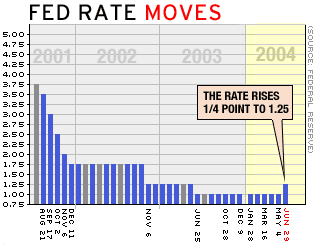NEW YORK (CNN/Money) -
The economy will likely shake off its recent spell of weakness, Federal Reserve Chairman Alan Greenspan told lawmakers Tuesday, meaning the super-low interest rates of recent years are no longer necessary.
The central bank chairman, in prepared remarks delivered to the Senate Banking Committee, said the economic recovery appeared to be self-sustaining, that inflation had picked up, and that the economy seemed prepared to handle higher rates.
"Financial markets, along with households and businesses, seem to be reasonably well prepared to cope with a transition to a more neutral stance of monetary policy," Greenspan said in his remarks.
He tempered his remarks by pointing out that, though inflation has risen faster this year than in 2003, some of that increase has been due to "transitory factors," including higher oil and gas prices.
He suggested those higher prices may have hurt consumer spending in June, implying that lower prices would ease inflationary pressures while also encouraging more consumer spending, which makes up more than two-thirds of the total economy.
Though he repeated the Fed's earlier pledge to be "measured" in raising rates, he again warned that the central bank could move more quickly if necessary.
"Mr. Greenspan is set to continue the unloosening, the risks of which are 'outweighed' by the benefits, and he'll go faster if he has to," said Ian Shepherdson, chief U.S. economist at High Frequency Economics.
Talk of stagflation
Bond markets appeared to take Greenspan's remarks as a sign that rate hikes would come somewhat more quickly than they expected. Bond prices fell, driving rates higher, as he spoke. Stock prices gave up some of their earlier gains, though they continued to trade higher.

"All in all, this is significantly more hawkish than I suspect market participants were anticipating," said Steve Stanley, economist with RBS Greenwich Capital. "Bond market players have been throwing around theories about a second half slowdown, with the June data creating a huge stir, but the Fed has almost not given that idea a second thought."
In its semi-annual monetary report to Congress, the Fed said it expected gross domestic product , the broadest measure of the nation's economy, to grow 4.5 to 4.75 percent in 2004. It expects its favored measure of prices, a Commerce Department reading on core consumer prices, to rise 1.75 percent to 2 percent.
Analysts pointed out that the Fed's forecast for GDP growth, the broadest measure of the economy, was lower than the forecast it made in February, while its forecast for inflation was higher.
What's more, the Fed expects just a small decline in the unemployment rate through 2005, expecting it to dip to between 5 and 5.25 percent from 5.6 percent last month.
Though very few analysts believe "stagflation" -- a state in which inflation is high, even as economic growth is slow, as it was throughout much of the 1970s -- is in train, Greenspan said policy makers were aware of the risks of stagflation and trying to fight it.
"This is always our concern. Most of us lived through the stagflation of the 1970s. It was a very disconcerting experience," he said in response to a lawmaker's question.
But he added that sharply higher oil prices were the cause of stagflation in the '70s, and noted that current oil prices weren't nearly as high, adjusted for inflation, as they were then.
Fast or slow?
At the end of June, Fed policy-makers raised their target for the fed funds rate, an overnight lending rate that influences other rates throughout the economy, to 1.25 percent from 1 percent, which had been the lowest level in more than 40 years. It was the Fed's first rate increase since May 2000.
Most analysts expect the Fed to continue to raise that target this year, to perhaps as high as 2.25 percent, a leisurely rate of increase. Many economists believe a more "neutral" level of fed funds is about 4 percent, a rate that may not be reached until 2005 or 2006.
So far, the economic data would seem to justify such a slow pace, as Greenspan noted in his testimony. An improving labor market has not yet pushed labor costs -- the biggest component of consumer price inflation -- particularly high, Greenspan said, and businesses continue to be cautious about spending money and hiring workers.
At the same time, Greenspan said the period of low interest rates -- which began with the first of 13 rate cuts in January 2001 -- had allowed businesses and consumers to clean up their balance sheets. Meanwhile, financial markets have already priced in higher rates, meaning further rate increases won't come as much of a shock to anybody.
Some analysts disagree, warning that higher rates will damage debt-laden consumers and cause pain in the housing market, which flourished amid the lowest mortgage rates in a generation.
And Greenspan acknowledged that a faster pace of tightening could be more troublesome than the slow and easy approach he now expects.
"Considerably more uncertainty and hence risk surrounds the behavior of the economy with a more rapid tightening of monetary policy than is the case when tightening is more measured," he said. "In either scenario, individual instances of financial strain cannot be ruled out."
New home construction fell precipitously in June, the Commerce Department said on Tuesday, but Greenspan said that report seemed to be an anomaly, coming in the context of still-low mortgage rates and strong demand for new homes.
"We don't perceive the June figure to be a harbinger of what's to come," he said in response to a lawmaker's question.

|